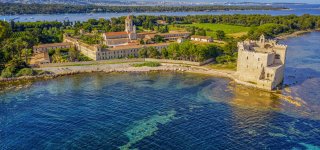The Lérins islands
Archipelago mythical face the red rocks of the Esterel mountains, the Lérins Islands are inseparable from Cannes and its heritage. The archipelago of Lérins consists of the main islands of Saint-Honorat and Sainte-Marguerite. Each has a small uninhabited island on its tip is: the island of Saint-Ferreol after the Ile Saint-Honorat Island and Tradelière after Saint Margaret. South of Saint-Honorat, the rock of Ilon is the fifth island archipelago account. Jewels of the Bay of Cannes, facing the end of the Croisette, the two larger islands have a natural and historical heritage of great wealth: Saint-Honorat houses Lérins Abbey, while the Royal island fort Sainte-Marguerite is related to the legend of the man in the iron mask.
To the north of the archipelago Lérins, Sainte-Marguerite is the larger of the two main islands. Occupied by the Ligurians and then the Romans from the 4th century BC to the 5th century AD, it became the property of the Lérins monks in the 5th century and will continue until the 15th. The construction of the Fort Royal, performed under Richelieu, when the first half of the 17th century. Vauban fortifications will inspect several times during the second half of the century. The fort then became prison. The imprisonment of the man in the iron mask in the fort of Sainte-Marguerite Island is dated from 1687 to 1698. Nearly two centuries later, the year 1874 was marked by the spectacular breakout of Marshal Bazaine convicted for his role in the defeat of France facing the Prussian armies in 1870. Ranked historic monument in 1927, the fort was occupied and used successively by the Italian and German armies during World War II. At the end of the 20th century, the Museum of the Sea Cannes is installed in the fort. The site also houses a Huguenot Memorial, which honors six Protestant ministers locked in the fort crime religion.
A few minutes by boat from the pier in Cannes, Sainte-Marguerite is a territory rich of an important historical past and exceptional natural heritage. Marked trails allow to visit the island by simultaneously discovering its natural resources, including botanical and historical heritage. Pond Batéguier home to many species of migratory birds. The nature trail to discover an infinite number of Mediterranean species. The Sea Museum houses a magnificent collection of underwater archeology and earth. Aquariums can discover the flora and coastal fauna of the islands. Paradisiacal creeks restaurant terraces complement the decor of Île Sainte-Marguerite, relaxing haven facing the center of Cannes.
Saint-Honorat welcomes meanwhile, in the 5th century, a community of monks who quickly radiates throughout Provence. The community of more than 500 monks massacred by the Saracens in 732. reconstituted, it will be attacked many times in the centuries that followed, undergoing 8 massacres in 200 years. In the 11th century built a fortified monastery. In the early 15th century, soldiers settled alongside the monks in the fortifications to defend the French coast. The power of the Benedictine monastery declines in the mid-17th century. The religious will all have left the island in 1788 and the abbey will be closed on royal decision. In ruins at the end of the 19th century, the monastery is then reinvested by Cistercian monks who rebuilt the church and community buildings on the remains of the old building. Always busy year by Cistercian monks, the monastery produces wines and the Lerina liqueur tasting is a must on the island.
